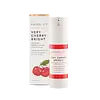What's inside
What's inside
 Key Ingredients
Key Ingredients

 Benefits
Benefits

 Concerns
Concerns

No concerns
 Ingredients Side-by-side
Ingredients Side-by-side

Water
Skin ConditioningButylene Glycol
HumectantGlycerin
HumectantCoco-Caprylate/Caprate
EmollientSqualane
EmollientPalmitoyl Grapevine Shoot Extract
AntioxidantPolyglyceryl-3 Distearate
EmulsifyingBisabolol
MaskingGlyceryl Stearate
EmollientXanthan Gum
EmulsifyingCaprylyl Glycol
EmollientMicrocrystalline Cellulose
AbsorbentPolyacrylate Crosspolymer-6
Emulsion StabilisingPotassium Sorbate
PreservativeGlyceryl Stearate Citrate
EmollientCitric Acid
BufferingSodium Phytate
Sodium Hydroxide
BufferingParfum
MaskingWater, Butylene Glycol, Glycerin, Coco-Caprylate/Caprate, Squalane, Palmitoyl Grapevine Shoot Extract, Polyglyceryl-3 Distearate, Bisabolol, Glyceryl Stearate, Xanthan Gum, Caprylyl Glycol, Microcrystalline Cellulose, Polyacrylate Crosspolymer-6, Potassium Sorbate, Glyceryl Stearate Citrate, Citric Acid, Sodium Phytate, Sodium Hydroxide, Parfum
Water
Skin ConditioningGlycerin
Humectant3-Glyceryl Ascorbate
AntioxidantPrunus Cerasus Fruit Water
Emollient3-O-Ethyl Ascorbic Acid
Skin ConditioningSodium Citrate
BufferingPropanediol
SolventMalpighia Punicifolia Fruit Extract
AntioxidantAscorbyl Tetraisopalmitate
AntioxidantGlucomannan
Skin ConditioningSodium Hyaluronate Crosspolymer
HumectantSodium Hyaluronate
HumectantHydrolyzed Sodium Hyaluronate
Skin ConditioningSodium Acetylated Hyaluronate
HumectantCalendula Officinalis Flower Extract
MaskingAllantoin
Skin ConditioningHydrolyzed Plukenetia Volubilis Seed Extract
Emulsion StabilisingPhysalis Angulata Extract
Skin ProtectingSorbitol
HumectantSodium Phytate
Biosaccharide Gum-1
HumectantPrunus Amygdalus Dulcis Fruit Extract
Skin ConditioningOryza Sativa Bran Extract
Skin ConditioningHelianthus Annuus Extract
EmollientSimmondsia Chinensis Seed Oil
EmollientTocopherol
AntioxidantRosmarinus Officinalis Leaf Extract
AntimicrobialVanilla Planifolia Fruit Extract
Skin ConditioningGlyceryl Caprylate
EmollientEthylhexylglycerin
Skin ConditioningCaprylyl Glyceryl Ether
CleansingSclerotium Gum
Emulsion StabilisingLithospermum Erythrorhizon Root Extract
Skin ConditioningCitric Acid
BufferingPolyglyceryl-4 Caprate
EmulsifyingPentylene Glycol
Skin ConditioningPolyglyceryl-6 Caprylate
EmulsifyingButylene Glycol
HumectantCaprylic/Capric Triglyceride
MaskingCaprylhydroxamic Acid
Sodium Levulinate
Skin ConditioningSodium Anisate
AntimicrobialSodium Benzoate
MaskingWater, Glycerin, 3-Glyceryl Ascorbate, Prunus Cerasus Fruit Water, 3-O-Ethyl Ascorbic Acid, Sodium Citrate, Propanediol, Malpighia Punicifolia Fruit Extract, Ascorbyl Tetraisopalmitate, Glucomannan, Sodium Hyaluronate Crosspolymer, Sodium Hyaluronate, Hydrolyzed Sodium Hyaluronate, Sodium Acetylated Hyaluronate, Calendula Officinalis Flower Extract, Allantoin, Hydrolyzed Plukenetia Volubilis Seed Extract, Physalis Angulata Extract, Sorbitol, Sodium Phytate, Biosaccharide Gum-1, Prunus Amygdalus Dulcis Fruit Extract, Oryza Sativa Bran Extract, Helianthus Annuus Extract, Simmondsia Chinensis Seed Oil, Tocopherol, Rosmarinus Officinalis Leaf Extract, Vanilla Planifolia Fruit Extract, Glyceryl Caprylate, Ethylhexylglycerin, Caprylyl Glyceryl Ether, Sclerotium Gum, Lithospermum Erythrorhizon Root Extract, Citric Acid, Polyglyceryl-4 Caprate, Pentylene Glycol, Polyglyceryl-6 Caprylate, Butylene Glycol, Caprylic/Capric Triglyceride, Caprylhydroxamic Acid, Sodium Levulinate, Sodium Anisate, Sodium Benzoate
 Reviews
Reviews

Ingredients Explained
These ingredients are found in both products.
Ingredients higher up in an ingredient list are typically present in a larger amount.
Butylene Glycol (or BG) is used within cosmetic products for a few different reasons:
Overall, Butylene Glycol is a safe and well-rounded ingredient that works well with other ingredients.
Though this ingredient works well with most skin types, some people with sensitive skin may experience a reaction such as allergic rashes, closed comedones, or itchiness.
Learn more about Butylene GlycolCitric Acid is an alpha hydroxy acid (AHA) naturally found in citrus fruits like oranges, lemons, and limes.
Like other AHAs, citric acid can exfoliate skin by breaking down the bonds that hold dead skin cells together. This helps reveal smoother and brighter skin underneath.
However, this exfoliating effect only happens at high concentrations (20%) which can be hard to find in cosmetic products.
Due to this, citric acid is usually included in small amounts as a pH adjuster. This helps keep products slightly more acidic and compatible with skin's natural pH.
In skincare formulas, citric acid can:
While it can provide some skin benefits, research shows lactic acid and glycolic acid are generally more effective and less irritating exfoliants.
Most citric acid used in skincare today is made by fermenting sugars (usually from molasses). This synthetic version is identical to the natural citrus form but easier to stabilize and use in formulations.
Read more about some other popular AHA's here:
Learn more about Citric AcidGlycerin is already naturally found in your skin. It helps moisturize and protect your skin.
A study from 2016 found glycerin to be more effective as a humectant than AHAs and hyaluronic acid.
As a humectant, it helps the skin stay hydrated by pulling moisture to your skin. The low molecular weight of glycerin allows it to pull moisture into the deeper layers of your skin.
Hydrated skin improves your skin barrier; Your skin barrier helps protect against irritants and bacteria.
Glycerin has also been found to have antimicrobial and antiviral properties. Due to these properties, glycerin is often used in wound and burn treatments.
In cosmetics, glycerin is usually derived from plants such as soybean or palm. However, it can also be sourced from animals, such as tallow or animal fat.
This ingredient is organic, colorless, odorless, and non-toxic.
Glycerin is the name for this ingredient in American English. British English uses Glycerol/Glycerine.
Learn more about GlycerinSodium Phytate is the synthetic salt form of phytic acid. Phytic acid is an antioxidant and can be found in plant seeds.
Sodium Phytate is a chelating agent. Chelating agents help prevent metals from binding to water. This helps stabilize the ingredients and the product.
Water. It's the most common cosmetic ingredient of all. You'll usually see it at the top of ingredient lists, meaning that it makes up the largest part of the product.
So why is it so popular? Water most often acts as a solvent - this means that it helps dissolve other ingredients into the formulation.
You'll also recognize water as that liquid we all need to stay alive. If you see this, drink a glass of water. Stay hydrated!
Learn more about Water